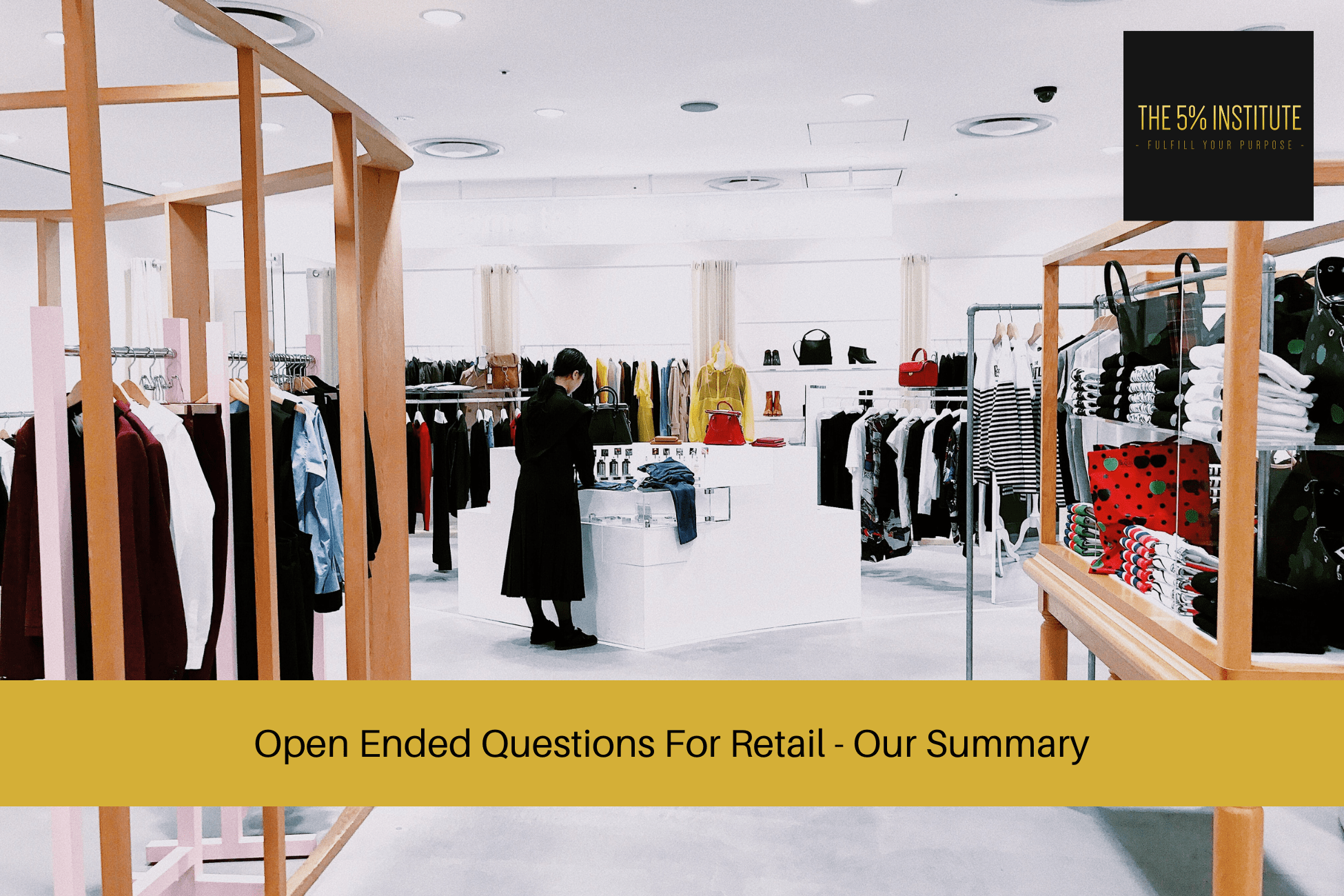
Open Ended Questions For Retail – Our Summary
In the highly competitive world of retail, understanding your customers’ needs and preferences is essential for success. One powerful tool that can help retailers gain valuable insights is the use of open-ended questions.
Unlike closed-ended questions that prompt simple “yes” or “no” answers, open-ended questions encourage customers to share their thoughts, feelings, and opinions in their own words.
This article explores the significance of open-ended questions in the retail industry, how they can be effectively implemented, and the benefits they bring to businesses.
Understanding Open-Ended Questions
Open-ended questions are queries that prompt customers to provide detailed responses.
These questions often start with phrases like “What do you think about…” or “How would you describe…” and allow customers to express themselves freely.
Unlike closed-ended questions that limit responses, open-ended questions create a conversational environment, encouraging customers to share valuable feedback and insights.
Importance of Open-Ended Questions in Retail
Creating Meaningful Customer Interactions
When retail staff uses open-ended questions during customer interactions, they show genuine interest in understanding the customers’ needs.
This approach fosters a strong connection between the customer and the brand, leading to enhanced customer loyalty and repeat business.
Gathering Valuable Customer Feedback
Open-ended questions enable retailers to gather detailed feedback from customers about their experiences.
This feedback provides actionable insights for improving products, services, and overall customer satisfaction.
Improving Customer Satisfaction
By actively listening to customers’ responses to open-ended questions, retailers can identify pain points and address them promptly.
This leads to improved customer satisfaction, which, in turn, contributes to positive word-of-mouth and customer referrals.
Boosting Sales and Upselling Opportunities
When retail staff engages customers with open-ended questions, they can better understand individual preferences and needs.
This understanding creates upselling and cross-selling opportunities, driving increased sales and revenue.
Implementing Open-Ended Questions in Your Retail Strategy
Training and Empowering Store Staff
Proper training is essential to ensure that retail staff understands the importance of open-ended questions and how to ask them effectively.
Empowering staff to use these questions confidently can lead to meaningful customer interactions.
Integrating Open-Ended Questions in Customer Surveys
Introducing open-ended questions in post-purchase or feedback surveys provides customers with a platform to express themselves fully.
Analysing these responses helps identify recurring themes and areas for improvement.
Enhancing the In-Store Experience
Implementing open-ended questions in the in-store experience, such as during product demonstrations or at the checkout counter, creates opportunities for customers to share feedback in real-time.
Leveraging Technology for Insights
Retailers can use advanced analytics tools to analyse large volumes of open-ended responses efficiently.
This data-driven approach helps in understanding customer sentiments and preferences on a deeper level.
Examples of Effective Open-Ended Questions
Exploring Customer Needs and Preferences
“What features do you look for when purchasing [product category]?”
“How would you envision using our [product name] in your daily life?”
Gauging Customer Satisfaction
“What aspects of your shopping experience delighted you the most today?”
“If there’s one thing we could improve upon, what would it be?”
Identifying Potential Improvements
“How can we make our store layout more convenient for you?”
“What additional products or services would you like to see us offer?”
The Art of Active Listening: Extracting Meaningful Insights
Listening attentively to customers’ responses is crucial to extract valuable insights.
By practicing active listening, retail staff can ask follow-up questions based on customers’ answers, showing that their feedback is genuinely valued.
Avoiding Biases in Open-Ended Questioning
Retailers must strive to remain impartial while asking open-ended questions to avoid influencing customers’ responses.
Keeping questions neutral and unbiased ensures authentic feedback.
Measuring Success: Metrics and Analysis
To gauge the effectiveness of open-ended questions, retailers can track metrics such as customer satisfaction scores, the number of product improvement suggestions received, and the percentage increase in sales.
Benefits of Regularly Using Open-Ended Questions
Consistently incorporating open-ended questions into retail interactions helps build stronger customer relationships, improve products and services, and stay ahead of competitors.
Addressing Common Challenges
While open-ended questions provide valuable insights, retailers may face challenges in handling large volumes of responses.
Implementing automation and AI-powered tools can aid in managing and analysing the data effectively.
Conclusion
Incorporating open-ended questions into a retail strategy can be a game-changer for businesses seeking to understand their customers better.
By actively engaging customers and listening to their feedback, retailers can foster meaningful connections, drive customer satisfaction, and boost sales.
Embracing the power of open-ended questions is a step towards building a customer-centric retail environment that thrives in today’s competitive market.
FAQs
Q: Are open-ended questions suitable for all types of retail businesses?
A: Yes, open-ended questions can benefit various retail businesses, including brick-and-mortar stores, e-commerce platforms, and service-oriented establishments.
Q: How frequently should retailers use open-ended questions?
A: Retailers should incorporate open-ended questions regularly, both in face-to-face interactions and surveys, to consistently gather valuable customer feedback.
Q: Can open-ended questions help in identifying emerging customer trends?
A: Absolutely! Open-ended questions allow retailers to stay ahead of emerging customer trends and adapt their strategies accordingly.
Q: What role does empathy play when using open-ended questions in retail?
A: Empathy is crucial when using open-ended questions, as it helps retail staff understand customers’ emotions and tailor responses accordingly.
Q: How can retailers encourage customers to provide detailed responses to open-ended questions?
A: Retailers can encourage detailed responses by assuring customers that their feedback is valued, offering incentives for participation, and making the process easy and user-friendly.
Want To Close Sales Easier?
Are you committed to closing sales a lot easier, and consistently?
If so, you should check out our self-paced and affordable online sales training program; The 5% Sales Blueprint.
It’ll give you everything you need to close sales consistently.
To learn more, simply click on the link below for more information.
Our Online Sales Training Program – The 5% Sales Blueprint.



